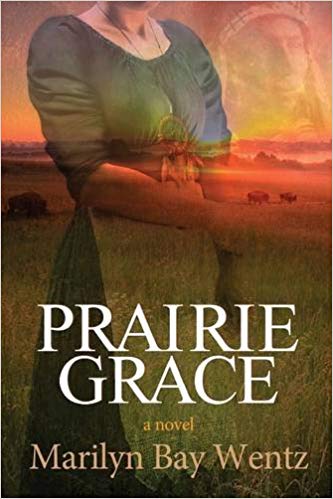Prairie Grace – Runner Up of the 2014 Colorado Book Award
Historical Fiction set in 1864 Colorado Territory
Published in 2013 (first in the Prairie historical fiction series)
Author: Marilyn Bay (published under Marilyn Bay Wentz)
In Prairie Grace, historic irony plays out as the eastern half of the United States is embroiled in the Civil War to end slavery, while military and political leaders in 1864 Colorado Territory strive to enslave the Native American population they see as impeding settlement and stalling gold exploration. Caught in the clash of cultures are real people, white and Native. Georgia MacBaye, a throw-caution-to-the-wind, adventure-seeking young frontierswoman is the daughter of former plantation owners turned homesteaders. Gray Wolf, a Cheyenne Indian brave who is gravely injured as the story opens, is thrown into the white world when his uncle, Chief Lean Bear, seeks help for him from Georgia’s mother, Loraine, a well-known healer. The MacBayes not only nurse Gray Wolf back to health, they also teach him their tongue, their ways, and their faith. Gray Wolf’s time in their home teaches the MacBayes to stop viewing Indians as sub-human menaces to be disposed of–an attitude common among settlers and politicians during this era–and to value them as fellow human beings.
Nearly a year later, Lean Bear has not returned to retrieve Gray Wolf, now a member of the MacBaye family. Gray Wolf and the MacBayes’ tranquil prairie lifestyle changes abruptly during a trip to Denver to sell cattle and grain and buy supplies for the coming year. Both Georgia and Gray Wolf are caught off guard by the Denverites’ venomous reaction to Gray Wolf. On the return trip, Georgia and Gray Wolf independently ponder their futures together.
An unexpected event sends Georgia into a tailspin, until she decides to deal with her disappointment by pursuing her dream of attending medical school. Georgia, the only female medical student at her school, finds success under the tutelage of her physician teacher, who encourages her to combine “modern” medical know-how with traditional herbal remedies. She and her male colleagues treat patients injured or diseased by the ravages of Denver’s devastating, historic flood, which took place in May 1864.
When Gray Wolf returns to his Native ways, including observing Cheyenne religious practices, he ponders conversations with Georgia’s father, Thomas. Gray Wolf believes the white man’s religion is flawed. He cannot accept a god whose son was not brave enough to fight but gave himself willing to be killed by and for people who hated him.
Known as the Indian Wars, hostilities during this time between warring Indians and soldiers bring terrible consequences to settlers, especially ranchers and farmers who have little protection from Indian attacks. Prairie Grace incorporates dozens of historic events, places and people into its storyline. Extensive research enables the author to accurately depict daily life and attitudes of people during this time, without being simplistic or stereotypical. The author’s expertise in agriculture, use of herbal and nutritional remedies and horse training provide believable descriptions of settler life.
The book culminates with news of the Sand Creek Massacre, which occurred November 29, 1864, in present day southeastern Colorado. Though less known than other massacres, the Sand Creek Massacre ended with the killing and mutilation of over 130 Indians, more than 100 of them women and children. Through divine grace, neither Gray Wolf nor Georgia is at the massacre site, but the cruelty, initially celebrated as a military victory, eventually provides them the resolve to stand together against the ungodly social mores of the time.
Prairie Grace dramatizes the worst and the best of humanity, as it accurately depicts both the Indian depredations and the ruthless U.S. government/military campaigns to eliminate the Native Americans and their threat or perceived threat to the whites. Broad research has enabled the author to write realistic dialog between fictional and actual historical figures. Historic events, including the Colorado gold rush, the Denver flood of 1864, the Hungate murders, the slaughter of innocent Indians in small villages, settlement on the Purgatory River in southeastern Colorado, Lean Bear’s visit with President Lincoln, and the treaties of Fort Laramie and Fort Wise are woven into the storyline. Historical figures Lean Bear, Bull Bear, Roman Nose, One-Eye, Beaver aka George Bent, Black Kettle, Tall Bull, Cheyenne captive Laura Roper, Issac Van Wormer, Indian Agent Samuel Colley, Edward Wynkoop, Silas Soule, Governor Evans, and Col. John Chivington all make appearances in Prairie Grace. The extent to which history is portrayed and daily routines-both Native and settler-described make Prairie Grace not just a good read but a history primer.

